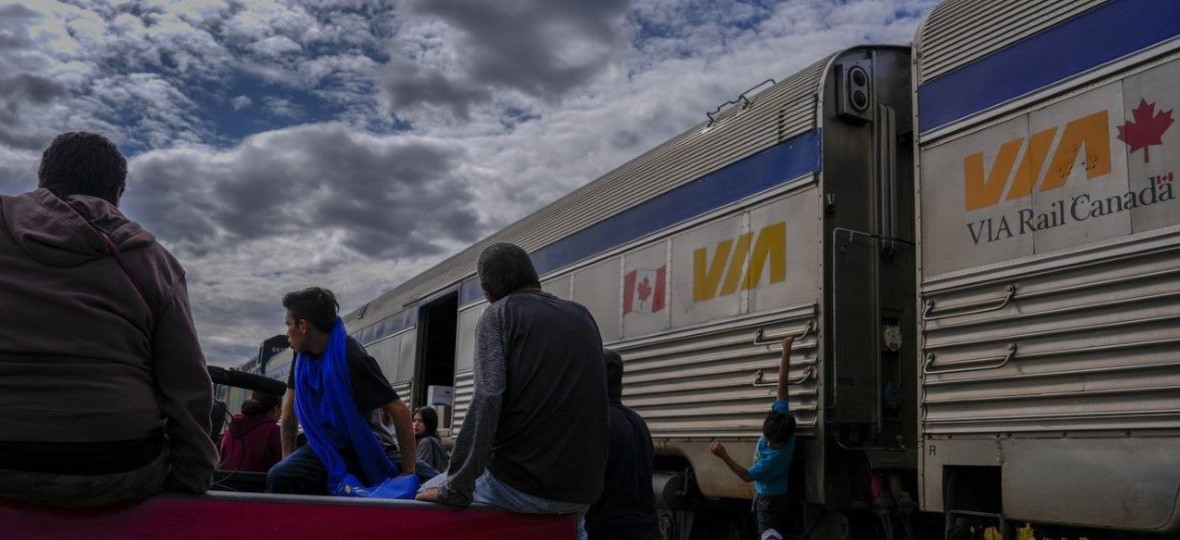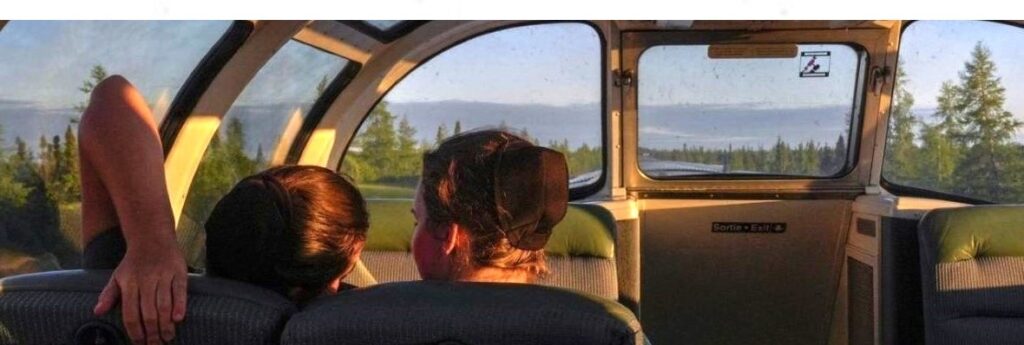By Seth Borenstein and Joshua A. Bickel
The setting sun backlights a pristine panoply of pines of different sizes and species. Far northern Canadian countryside rolls by at a leisurely pace of a train ride, viewed through an upper deck glass-enclosed of a special observation car. Waves of green and brown in slightly varying shades sweep by.
It’s mesmerizing and calming and there’s no working Wi-Fi to interrupt with emails or social media demanding attention. Two or three hours pass peacefully without notice. Now repeat. Repeat again. And again. Two hours becomes two days.
To get between Churchill, Man. – the polar bear and beluga whale capital of the world and a tourist hot spot for northern adventure tourism – and Winnipeg, there are only two options: A $1,100 one-way plane flight that takes two-and-a-half hours or a scenic 45-hour to 49-hour much cheaper train ride. It’s a $200 train ride like few others from the glass ceiling of the observation car Canada’s VIA railroad bills it as a “scenic adventure.”
It starts with a vista of the tree-less but not quite barren tundra, then powers through hours of tall forests. They eventually give way to more manicured cropland with the occasional animal, even a herd of elk. Sunset glimmers off a lake. When night comes it holds the hope of a Northern Lights sighting stretching all around. If there are no glimmering auroras, there’s a special beauty in the pitch-black outside with only the lights of the train interrupting.
And it goes on for 1,697 km. There are 10 listed stops enroute with some only for a few minutes and others a few hours. It’s Churchill’s connection to the rest of the world
While the train is a lifeline for the town of Churchill, it’s also promoted for tourism. The community has roads inside town and for a few miles to the outskirts, but no roads go to other cities. So, it’s expensive flying or an overnight train ride at a more reasonable price tag.

Sleeper berths are available on the train, along with shower cubicles the size of those in a New York hotel room, but for those traveling more cheaply or booking late, there are standard seats in the cabin. The seats recline – mostly. But it’s not full laying down.
Food is also limited. There is a small galley below the observation deck. It has some food, heated by a microwave. The train does serve beer, but limited brands. Frequent commuters and those who do their research know to bring their own snacks on board, and make the most of the restaurants at longer stops in towns on route.
Stations along the way vary greatly: In Dauphin, passengers wait outside an historic brick station built in 1912, but in Wabowden, a single yellow sign nailed to a pole near the track that reads “Muster Point” alerts passengers to the stop.
At Thompson – just under halfway between Churchill and Winnipeg – passengers are better connected – and fed. At about 13,600 residents, it’s the biggest community the train stops at, besides Winnipeg, with amenities like big-box stores and restaurants.
After leaving Thompson, the train heads to remote First Nation communities on both sides of the route.
And though the journey distance-wise is short, it takes hours by train, with many passengers passing the time playing cards and chatting with each other in the dining car.
The town of The Pas, one of the longer stop on the route, includes a bar right by the station. But the train’s porter warned passengers off it, saying it was a rather rough establishment. She knew because she has been there.
The train also ventured into a different zone in eastern Saskatchewan and the cute downtown of Canora, which strangely wasn’t on the train schedule for stops.
As the train heads further south, the landscape changes, the northern forest giving way to crop fields and livestock as the route approaches Winnipeg. And finally, after 49 hours, the train pulls into Winnipeg.
This glimpse into the beautiful monotony of vast stretches of untouched trees and tan tundra is a trip of a lifetime, which – for some passengers at least – seemed to last that long.
If you enjoyed or found this story useful, we’d appreciate if you would forward it to a colleague or friend who may also enjoy it. If, on the other hand, a friend shared it with you, welcome! You can get all the latest travel news and reviews from Travel Industry by simply clicking HERE.

